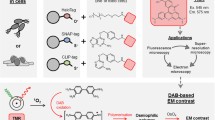Abstract
Recent advances in the field of small molecule labels for live cell imaging promise to overcome some of the limitations set by the size of fluorescent proteins. We tested the tetracysteine–biarsenical labeling system in live cell fluorescence microscopy of reggie-1/flotillin-2 in HeLa and N2a cells. In both cell types, the biarsenical staining reagent FlAsH/Lumio Green accumulated in active mitochondria and led to mitochondrial swelling. This is indicative of toxic side effects caused by arsenic, which should be considered when this labeling system is to be used in live cell imaging. Mitochondrial accumulation of FlAsH/Lumio Green was reversed by addition of low concentrations of thiol-containing reagents during labeling and a subsequent high stringency thiol wash. Both ethanedithiol and β-mercaptoethanol proved to be effective. We therefore established a staining protocol using β-mercaptoethanol as thiol binding site competitor resulting in a specific staining of tetracysteine-tagged reggie-1/flotillin-2 of adequate signal to noise ratio, so that the more toxic and inconvenient ethanedithiol could be avoided. Furthermore, we show that staining efficiency was greatly enhanced by introducing a second tetracysteine sequence in tandem.


Similar content being viewed by others
References
Abramoff MD, Magelhaes PJ, Ram SJ (2004) Image processing with image. J Biophotonics Int 11:36–42
Andresen M, Schmitz-Salue R, Jakobs S (2004) Short tetracysteine tags to beta-tubulin demonstrate the significance of small labels for live cell imaging. Mol Biol Cell 15:5616–5622
Chen I, Ting AY (2005) Site-specific labeling of proteins with small molecules in live cells. Curr Opin Biotechnol 16:35–40
Dalton WS (2002) Targeting the mitochondria: an exciting new approach to myeloma therapy. Commentary re: Bahlis NJ et al. (2002) Feasibility and correlates of arsenic trioxide combined with ascorbic acid-mediated depletion of intracellular glutathione for the treatment of relapsed/refractory multiple myeloma. Clin Cancer Res 8:3658–3668. Clin Cancer Res 8:3643–3645
Gaietta G, Deerinck TJ, Adams SR, Bouwer J, Tour O, Laird DW, Sosinsky GE, Tsien RY, Ellisman MH (2002) Multicolor and electron microscopic imaging of connexin trafficking. Science 296:503–507
Griffin BA, Adams SR, Jones J, Tsien RY (2000) Fluorescent labeling of recombinant proteins in living cells with FlAsH. Methods Enzymol 327:565–578
Griffin BA, Adams SR, Tsien RY (1998) Specific covalent labeling of recombinant protein molecules inside live cells. Science 281:269–272
Lang DM, Lommel S, Jung M, Ankerhold R, Petrausch B, Laessing U, Wiechers MF, Plattner H, Stuermer CA (1998) Identification of reggie-1 and reggie-2 as plasmamembrane-associated proteins which cocluster with activated GPI-anchored cell adhesion molecules in non-caveolar micropatches in neurons. J Neurobiol 37: 502–523
Langhorst MF, Reuter A, Stuermer CA (2005) Scaffolding microdomains and beyond: the function of reggie/flotillin proteins. Cell Mol Life Sci 62:2228–2240
Lindahl PE, Oberg KE (1960) Mechanism of the physiological action of rotenone. Nature 187:784
Lippincott-Schwartz J, Snapp E, Kenworthy A (2001) Studying protein dynamics in living cells. Nat Rev Mol Cell Biol 2:444–456
Marek KW, Davis GW (2002) Transgenically encoded protein photoinactivation (FlAsH-FALI): acute inactivation of synaptotagmin I. Neuron 36:805–813
Martin BR, Giepmans BN, Adams SR, Tsien RY (2005) Mammalian cell-based optimization of the biarsenical-binding tetracysteine motif for improved fluorescence and affinity. Nat Biotechnol 23(10):1308–1314
Neumann-Giesen C, Falkenbach B, Beicht P, Claasen S, Luers G, Stuermer CA, Herzog V, Tikkanen R (2004) Membrane and raft association of reggie-1/flotillin-2: role of myristoylation, palmitoylation and oligomerization and induction of filopodia by overexpression. Biochem J 378:509–518
Schulte T, Paschke KA, Laessing U, Lottspeich F, Stuermer CA (1997) Reggie-1 and reggie-2, two cell surface proteins expressed by retinal ganglion cells during axon regeneration. Development 124:577–87
Song L, Hennink EJ, Young IT, Tanke HJ (1995) Photobleaching kinetics of fluorescein in quantitative fluorescence microscopy. Biophys J 68:2588–600
Stroffekova K, Proenza C, Beam KG (2001) The protein-labeling reagent FLASH-EDT2 binds not only to CCXXCC motifs but also non-specifically to endogenous cysteine-rich proteins. Pflugers Arch 442:859–66
Tour O, Meijer RM, Zacharias DA, Adams SR, Tsien RY (2003) Genetically targeted chromophore-assisted light inactivation. Nat Biotechnol 21:1505–1508
Urano Y, Kamiya M, Kanda K, Ueno T, Hirose K, Nagano T (2005) Evolution of fluorescein as a platform for finely tunable fluorescence probes. J Am Chem Soc 127:4888–4894
Zmuda J, Friedenson B (1983) Changes in intracellular glutathione levels in stimulated and unstimulated lymphocytes in the presence of 2-mercaptoethanol or cysteine. J Immunol 130:362–364
Acknowledgements
We thank Gonzalo Solis and Alexander Reuter for their help with cloning of the R1-Cys4-expression vectors. This work was supported by grants from the Deutsche Forschungsgemeinschaft DFG (SFB-TR11), the Ministerium Forschung, Wissenschaft und Kunst Baden-Württemberg (TSE program) and the Fonds der Chemischen Industrie.
Author information
Authors and Affiliations
Corresponding author
Additional information
M.F. Langhorst and S. Genisyuerek contributed equally to this work.
Rights and permissions
About this article
Cite this article
Langhorst, M.F., Genisyuerek, S. & Stuermer, C.A. Accumulation of FlAsH/Lumio Green in active mitochondria can be reversed by β-mercaptoethanol for specific staining of tetracysteine-tagged proteins. Histochem Cell Biol 125, 743–747 (2006). https://doi.org/10.1007/s00418-005-0136-3
Accepted:
Published:
Issue Date:
DOI: https://doi.org/10.1007/s00418-005-0136-3




